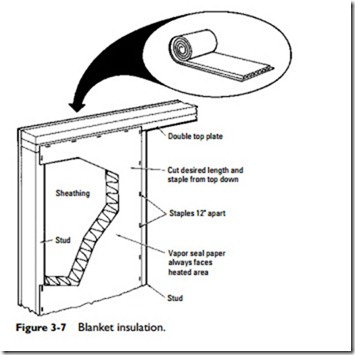Blanket or Batt Insulation
Blanket or batt insulation is commonly made from rock wool or fiberglass. Standard rock wool blankets or batts have an R-value of 3.2 per inch thickness; fiberglass blankets or batts, an R-value of 3.1. Some manufacturers now produce medium- and high-density blankets and batts with higher R-values, ranging from R-11 to as high as R-38, depending on the thickness.
Note
The term mineral wool, which is often used in reference to blankets and batts, refers to the following three basically similar types of insulation: (1) fiberglass or glass wool, produced from recycled glass; (2) rock wool, produced from basalt; and (3) slag wool, produced from steel-mill slag.
Blanket insulation (Figure 3-7) is produced in the form of a continuous flexible strip and is generally available in rolls or packs ranging in thickness from 1 to 3 in. Widths are commonly 15 in, but wider blankets or batts with widths up to 33 in can be obtained on special order. Blanket insulation lengths range from 36 to 48 ft. Batts (Figure 3-8) are essentially smaller examples of blanket insu- lation, ranging in thicknesses from 1 to 6 in and available in 4- and 8-ft lengths.
Blankets and batts commonly are manufactured with a vapor seal paper attached to one face, covering the entire surface and extending 11⁄2 in outside the blanket or batt. These 11⁄2-in laps, neatly folded against the membrane backing in manufacture, are turned out and tacked or stapled to the studs, rafters, or joists in application. The paper backing helps to prevent the passage of vapor and resists the penetration of moisture from excess water in fresh plaster or other sources.
